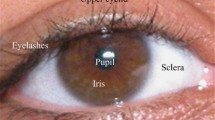Abstract
We explore the effects of time lapse on iris biometrics using a data set of images with four years time lapse between the earliest and most recent images of an iris (13 subjects, 26 irises, 1809 total images). We find that the average fractional Hamming distance for a match between two images of an iris taken four years apart is statistically significantly larger than the match for images with only a few months time lapse between them. A possible implication of our results is that iris biometric enrollment templates may undergo aging and that iris biometric enrollment may not be “once for life.” To our knowledge, this is the first and only experimental study of iris match scores under long (multi-year) time lapse.
Chapter PDF
Similar content being viewed by others
References
Daugman, J.: How Iris Recognition Works. IEEE Trans. Circuits and Sys. for Video Tech. 14(1), 21–30 (2004)
LG, http://www.lgiris.com/ (accessed, August 2008)
Thornton, J., Savvides, M., Kumar, V.: A Bayesian Approach to Deformed Pattern Matching of Iris Images. IEEE Trans. Pattern Anal. and Mach. Intell. 29(4), 596–606 (2007)
Miyazawa, K., Ito, K., Aoki, T., Kobayashi, K., Nakajima, H.: An Effective Approach for Iris Recognition Using Phase-Based Image Matching. IEEE Trans. Pattern Anal. and Mach. Intell. 30(10), 1741–1756 (2008)
Monro, D., Rakshit, S., Zhang, D.: DCT-Based Iris Recognition. IEEE Trans. Pattern Anal. and Mach. Intell. 29(4), 586–595 (2007)
Liu, X., Bowyer, K., Flynn, P.: Experiments with an improved iris segmentation algorithm. In: Fourth IEEE Workshop on Automatic Identification Technologies, Oct. 2005, pp. 118–123 (2005)
Liu, X.: Optimizations in Iris Recognition. PhD Dissertation, University of Notre Dame (2006)
National Institute of Standards and Technology. Iris Challenge Evaluation (2006) http://iris.nist.gov/ice
Hollingsworth, K., Bowyer, K., Flynn, P.: The Best Bits in an Iris Code. IEEE Trans. Pattern Anal. and Mach. Intell (in press)
Phillips, J., Bowyer, K., Flynn, P., Liu, X., Scruggs, T.: The Iris Challenge Evaluation 2005. In: 2008 IEEE Conf. on Biometrics: Theory, Applications, and Systems,
Tome-Gonzalez, P., Alonso-Fernandez, F., Ortega-Garcia, J.: On the Effects of Time Variability in Iris Recognition. In: 2008 IEEE Conf. on Biometrics: Theory, Applications and Systems (2008)
Daugman, J.: New Methods in Iris Recognition. IEEE Trans. Sys., Man, and Cyber. 37(5), 1167–1175 (2007)
Hollingsworth, K., Bowyer, K., Flynn, P.: Pupil Dilation Degrades Iris Biometric Performance. In: Computer Vision and Image Understanding (in press)
Bowyer, K.W., Hollingsworth, K.P., Flynn, P.J.: Image Understanding for Iris Biometrics: A Survey. Computer Vision and Image Understanding 110(2), 281–307 (2008)
Ring, S., Bowyer, K.: Detection of Iris Texture Distortions by Analyzing Iris Code Matching Results. In: IEEE Conf. on Biometrics: Theory, Applications, and Systems (2008)
Kalka, N., Zui, J., Schmid, N., Cukic, B.: Image Quality Assessment for Iris Biometric. SPIE 6202: Biometric Technology for Human Identification III, D1–D11 (2006)
Author information
Authors and Affiliations
Editor information
Editors and Affiliations
Rights and permissions
Copyright information
© 2009 Springer-Verlag Berlin Heidelberg
About this paper
Cite this paper
Baker, S.E., Bowyer, K.W., Flynn, P.J. (2009). Empirical Evidence for Correct Iris Match Score Degradation with Increased Time-Lapse between Gallery and Probe Matches. In: Tistarelli, M., Nixon, M.S. (eds) Advances in Biometrics. ICB 2009. Lecture Notes in Computer Science, vol 5558. Springer, Berlin, Heidelberg. https://doi.org/10.1007/978-3-642-01793-3_118
Download citation
DOI: https://doi.org/10.1007/978-3-642-01793-3_118
Publisher Name: Springer, Berlin, Heidelberg
Print ISBN: 978-3-642-01792-6
Online ISBN: 978-3-642-01793-3
eBook Packages: Computer ScienceComputer Science (R0)




